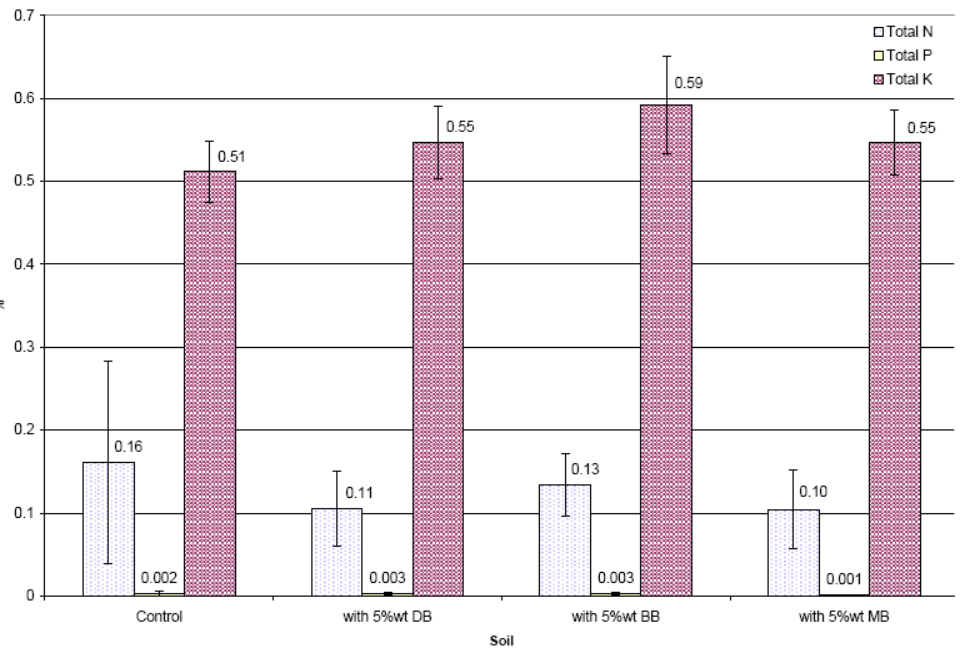The development of soil quality using biochar amendment from agricultural waste
DOI:
https://doi.org/10.60136/bas.v4.2015.303Keywords:
Biochar, Soil amendment, Agricultural wasteAbstract
The development of highland soil quality using biochar amendment from agricultural waste was aimed to utilize the use of agricultural biomass as the substitution of chemical in agricultural fields. The experiment was conducted by pyrolysis biochar from durian shell, banana peel, and macadamia shell at low temperature (< 400 degree celcius) using Anila stove type gasifier. The biochar obtained in this study had the pH in the range of 7-10 depend on the type of raw materials. Each type of biochar was added to the highland soil from Phuruea, Loei Province, Thailand to study the liming effect. It was found that the 5% wt addition of biochar increased the pH of soil from 6 to 7, and biochar treated soil had more stability than the lime treatment at the same application rate. Moreover, the 5%wt of biochars were then added to the olive tree experiment plot at the Highland Agriculture Research and Development Center, Phuruea, Loei Province. After a year of application, the soil was collected and characterized. The results showed that the biochar application increased the pH of the soil to neutral range and also significantly increased the moisture, organic matter and potassium in soil in compared with non-treated soil.
References
LEHMANN, J., GAUNT, J. and RONDON, M. Bio-char sequestration in terrestrial ecosystems - a review. Mitigation and Adaptation Strategies for Global Change, 2006, 11(2), 395-419.
ATKINSON, C.J. and FITZGERALD, J. D. Portential mechanisms for achieving agricultural benefits from biochar application to temperate soils: a review. Plant Soil, 2010, 337(1), 1-18.
FREIBAUER, A. et al. Carbon sequestration in agricultural soil of Europe. Geoderma, 2004, 122(1): 1-23.
PRABHA, S. V. et al. A study of the fertility and carbon sequestration potential of rice soil with respect to the application of biochar and selected amendments. Annals of Environmental Sceince, 2013, 7, 17-30.
DEMIRBAS, A. Effects of temperature and particle size on bio-char yield from pyrolysis of agricultural residues. Journal of Analytical and Applied Pyrolysis, 2004, 72(2), 243-248.
PENG, X. et al. Temperature- and duration-dependent rice straw-derived biochar: Characteristics and its effects on soilproperties of an Ultisol in southern China. Soil an d Tillage Research, 2011, 112(2), 159-166.
WANG, L. et al. Effect of crop residue biochar on soil acidity amelioration in strongly acidic tea garden soils. Soil Use and Management, 2014, 30(1), 119-128.
ASAI, H. et al. Biochar amendment techniques for upland rice production in Norther Loas 1. Soil physical properties, leaf SPAD and grain yield. Field Crops Research, 2009, 111(1-2), 81-84.
AHMED KHAN, M. et al. Nutrient-impregnated charcoal: an environmentally friendly slow-release fertilizer. Environmentalist, 2008, 28(3), 231-235.
NOVAK, J. et al. Impact of biochar amendment on fertility of a southeastern coastal plain soil. Soil Science, 2009, 174(2), 105-112.
MUKHERJEE, A. et al. Surface chemistry variation among a series of laboratory-produced biochars. Geoderma, 2011, 163(34), 247-255.
สํานักวิทยาศาสตร์เพื่อการพัฒนาที่ดิน, 2547. คู่มือวิเคราะห์ตัวอย่างดิน น้ํา ปุ๋ย พืช วัสดุปรับปรุงดิน และการตรวจวิเคราะห์เพื่อการรับรองมาตรฐานสินค้าเล่ม 1. [กรุงเทพฯ) : กรมพัฒนาที่ดิน. 184 หน้า
RICHARDS, L. A. Capillary conduction of liquids through porous mediums. Journal of Applied Physics, 1931, 1, 318-333.
YOUNG, B. C. Factors affecting the volatile-matter yield from chars. Fuel, 1980, 59(2), 107-111.
HAYNES, R. J. and NAIDU, R. Influence of lime fertilizer and manure applications on soil organic matter content and soil physical conditions: a review. Nutrient Cycling in Agroecosystems, 1998, 51(2). 123-37.

Downloads
Published
How to Cite
Issue
Section
License
Copyright (c) 2022 Bulletin of Applied Sciences

This work is licensed under a Creative Commons Attribution-NonCommercial-NoDerivatives 4.0 International License.









